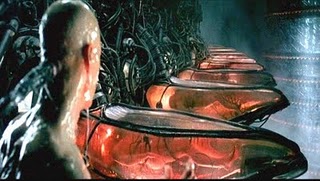For this week’s blog discussing types of shots and shot progression in film, my movie of choice is one of my absolute favorites, The Matrix. The film has a complex plot in which the human population has been enslaved by machines capable of intelligent thought, and the mind of every person has been connected to a computer generated simulator called the matrix in which everyone lives out their lives while the machines use their bodies as energy sources. In the reality outside of the simulated world, a small resistance fights to free the rest of mankind from the machines and searches for “The One”, a prophesized man with the ability to change the matrix itself and break its rules.
A very iconic scene takes place when the protagonist, named Neo and played by Keanu Reeves, awakens from the matrix for the first time and finds himself within a fluid filled pod. He pulls a lengthy tube out of his throat and discovers tubes connected to every limb of his body. This scene is both essential to the film’s narrative and makes use of three types of shot, giving it a foreboding emotional aura.
As he first awakens, breaks through the outer covering of the pod, and notices the plugs attached to him, the director uses a close up shot and focuses directly on him, at just about eye level. This gives the viewer a keen perspective of his emotions of confusion and fear upon reaching consciousness in such a frightening environment. It is imperative that this shot comes first so that Neo’s initial feelings can be most accurately conveyed before the scene can continue, and only a close up will allow such focus.
Neo next turns to his left and a medium shot is used. The camera is positioned behind his head at eye level so the viewer is given the perspective of seeing what he sees. Peering to the left, there are several other pods identical to his in a row, each containing a person unconscious and encased in an organic fluid just as he was moments earlier. This shot is important not only to give the viewer greater information about the situation in which the protagonist finds himself but also amplifies his emotions and confusion. Up until the point Neo is in a strange situation but it is not known whether he is alone or not. The medium shot answers this question.
The last and most important shot used in the scene is the long shot. After looking over to his left, Neo looks down over the front end of his pod. The director positions this shot far above Neo’s head, making him appear smaller in relation to his surrounding environment. As he sees what is over the edge, the viewer too is alerted to the fact that his pod is in a tower of thousands upon thousands of other pods, and the ground is so far away it cannot be seen. All within view are his and other towers composed of pods like his. It is the ultimate shot in terms of loneliness for in this moment Neo realizes that he is completely alone and isolated from all he knows, the only awakened person in a sea of comatose individuals.



No comments:
Post a Comment